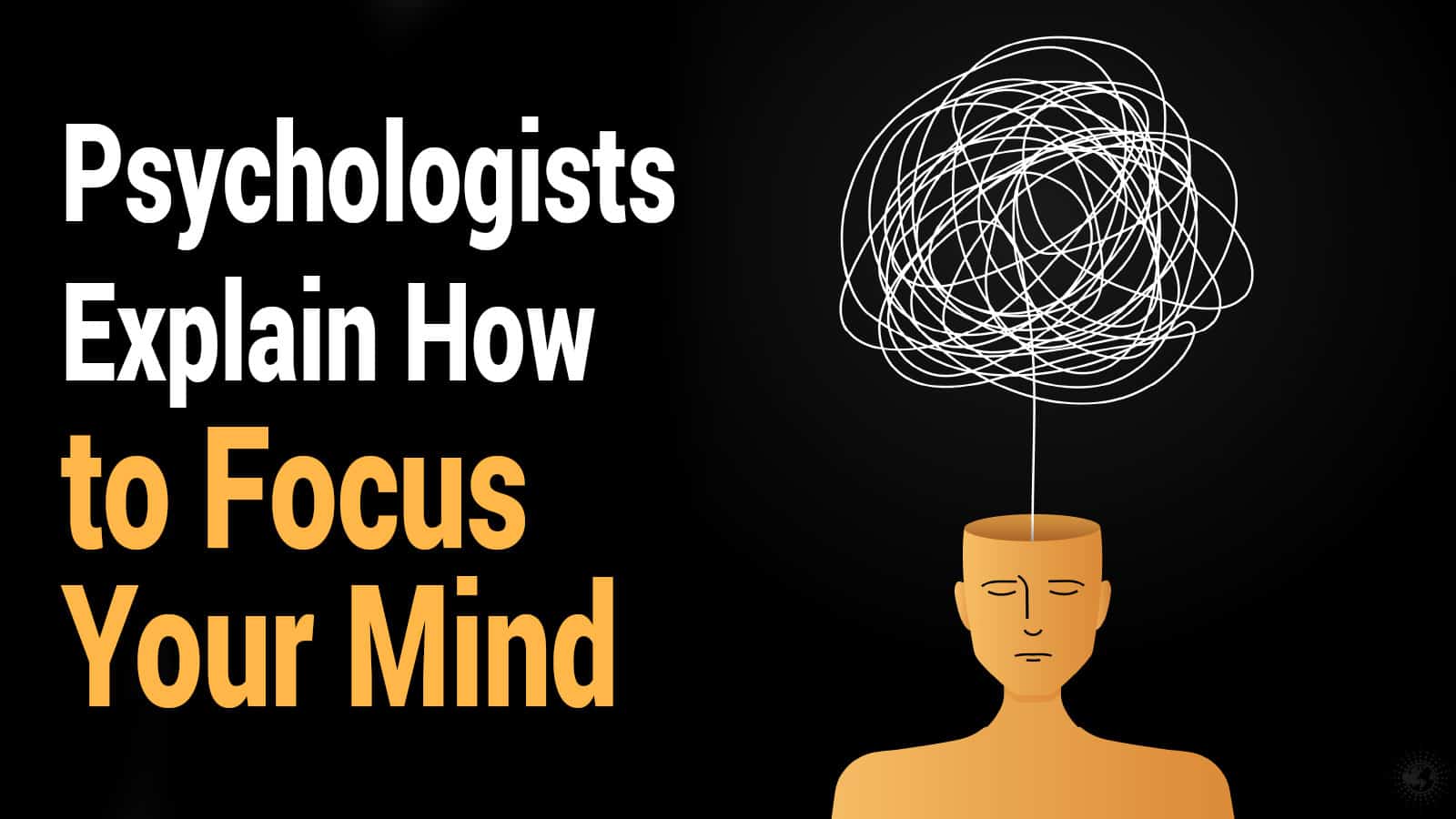Frazzled. Confused. Stressed. Discombobulated. Scatterbrained. These are just a few ways of describing the tendencies of the human mind.
Indeed, it can be difficult to understand ourselves. It’s not altogether uncommon to wonder, “Where’d that thought come from?” It’s a fair question, too! Why do we produce random thoughts – and why are the majority of them self-defeating? To answer this question, we must look at the brain’s two modes: default and focused.
“My mind is like an internet browser. 17 tabs are open, 4 of them are frozen and I don’t know where the music is coming from.” – Unknown (source)
Understanding Your Mind’s Two Modes
By understanding your mind’s two modes, you’ll unlock the secret to better focus.
Mode 1: The Default Mode
“A wandering mind costs you nothing but is very expensive.” – Amit Sood, M.D.
Did you know that “at rest” really isn’t resting much at all? Neurophysiologists state that the focused mind uses just five percent more than a mind doing nothing in particular. The paradox here is that your mind is always doing something – even when you’re doing nothing – and this comes at an energy cost.
It is when we’re bored that the brain enters its default mode. If the brain could talk, it would say something like this: “Is this something interesting that is worth my time? No? Leave me alone to brood.” This brooding always takes place when the brain is in default mode.
Most people will recognize when their brain is in its default state, but not all. Some people feel as if their attention rarely wanders or enters default mode. Unless you are a monk or a long-time meditation or yoga practitioner, this is probably untrue. But here are a few questions to answer if you think this is the case:
- Do my family or friends complain that I’m often too distracted?
- Do I arrive at home with little memory of the commute?
- Have I become more forgetful?
- Do I experience mind racing in the shower?
- Have I ever read a book with no idea of what I just read?
- Do my thoughts wander when someone is talking or giving a presentation?
- Do I wake up to a mind whirling with thoughts?
If you’ve answered in the affirmative to any of the above questions, your brain was in its default state. Please remember this about the default mode: the default mode takes away from your enjoyment of life; in fact, it often contributes to the pain and suffering you sometimes feel.
Mode 2: The Focused Mode
“Concentration brings with it a natural job as the mind settles and is absent of distraction.” – Shaila Catherine (source)
The brain’s secondary mode – and unfortunately so – is the focused mode. It’s not a stretch to say that the focused mode is the answer to most of life’s ills. This mode is recognizable when you become absorbed in something and lose track of time. Activities that activate focused mode includes:
- Eating a delicious meal
- Reading a good book
- Watching an enthralling movie
- Staring at a newborn baby
- Watching the sunset
- Solving a meaningful problem
The focused mind is relatively free of distractions, including the inner distractions of anxiety, restlessness, boredom, and so forth. As such, the focused mind is a happy mind. The focused mind becomes activated while you are paying attention to anything interesting and meaningful.
While there aren’t any official statistics on how often a person spends their time in focused mode, it’s probably in the ballpark of 25 percent. But fret not. You can substantially increase the amount of time that you spend in focused mode by committing to do so. This process takes a bit of effort at first but quickly becomes rather effortless. More on this later.
The Human Mind is Beautiful
How powerful is what you just read? Simply by knowing and being mindful of the brain’s two “modes,” you can live a happier, more peaceful, and more meaningful life. Your brain innately understands the differences between the two modes – and the above descriptions should help.
Remember the differences:
– Default mode: anxiety, stress, depression, restlessness; internally-focused, directionless. The majority of people spend most of their time in this state.
– Focused mode: content, happy, peaceful; externally-focused, time seems to fly. Most of us only spend about 25 percent in this state.
“Why can’t I stay in default mode?”
Listen up as this is a critical point: no matter how much you learn about the brain and its processes, you will never be able to remain in a state of complete focus. How often you can stay in focused mode depends upon your initial capacity for attention, as well as your willingness to learn mindful techniques like meditation.
But what are these things even required? Why can‘t you just stay in a focused state? Well, as great as being focused all of the time sounds, it would be counterproductive and even dangerous.
Our brain has evolved an autonomic system that responds to threats – real or perceived. How important is the autonomic nervous system? Have you ever involuntarily taken a breath or moved to avoid a collision with a car or person? Sure, you have – all of us do this. It’s called survival, and our brain and body are finely tuned to survive in even the most challenging scenarios.
The problem is that the brain doesn’t know the difference between real and perceived threats. It is when we are prone to mind-wandering that these threats become more challenging and profuse. Biologically, the human brain in its current state is not designed to allow conscious thought to dominate. Will the brain ever reach that point? That remains to be seen.
Overcoming Resistance in the Mind
“What you resist not only persists but will grow in size.” – Carl Jung (source)
Read and re-read the following statement as often as you’d like: to resist wandering thoughts is futile. Go ahead, reread it.
One of the first things that someone does when trying to get into a more focused state is to suppress wandering thoughts. Not only does this fail, but it actually makes things worse. Think of trying to resist negative or wandering thoughts as tightening a spring – the harder that you try, the more it recoils.
What is the answer, then? To bring the wandering mind back to the task, whatever it happens to be – whether reading a book, writing a paper, having a conversation, etc. – over and over again without denying other mental states. It is this directing and re-directing of focus that allows your attentional muscles to grow.
Remembering to redirect your attention throughout the day can be challenging, but it isn’t the most challenging part. The hardest part is resisting the urge to criticize yourself for losing focus in the first place. You must try and get over this tendency as much as possible. Not only will self-criticism drain your mental energy, but it may very well derail any efforts to become more focused and mindful.
Final Thoughts on the Human Mind: A Blueprint for Focus
“Everyone in your life is vying for your attention.” – Isaiah Hankel, Ph.D. (source)
Here’ s another tidbit that you may want to keep in mind: distractions (i.e. mind wandering) further depletes your brain’s energy levels. In turn, this energy depletion makes it easier to succumb to distractions.
What to do? Here’s a four-point blueprint for maximizing focus.
Point #1 – Monitor your attention.
You must track where your attention is going to make better use of it. When do you feel the most focused and attentive? What things cause you to lose focus on the task at hand? Track these things and prepare a plan of action.
Point #2 – Manage your emotions.
There is a correlation between mental and bodily emotions and energy. If you are feeling happy or content, your brain will be more alert and active than if you’re downtrodden and lethargic. Do the things that make you feel more of the former and less of the things that make you feel more of the latter.
Point #3 – Leverage technology.
While it may sound downright paradoxical to call upon tech for more focus, the right type of technology can indeed help. Try downloading an app that blocks distracting websites. Or maybe one that tracks productivity and emails daily reports. Do whatever works for you.
Point #4 – Don’t give up.
For the vast majority, building up a cognitive reserve of focus is a timely and challenging undertaking. Don’t allow your emotions and negative self-talk (both forms of mind-wandering) to take you off track. If you put in the time and effort, you will be a more focused, happier, and productive individual!














 Community
Community

